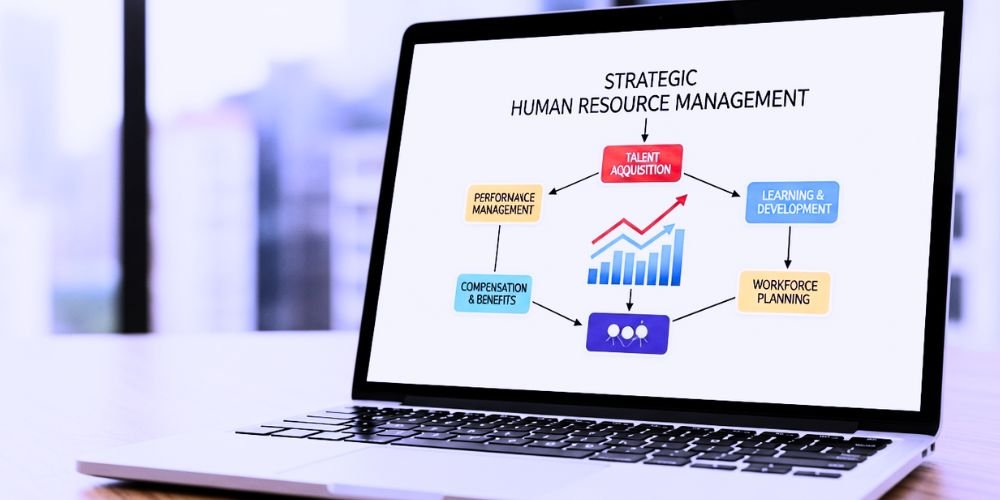Strategic Human Resource Management is a progressive and forward-thinking approach that integrates human resources practices with an organization’s strategic objectives. Unlike traditional HR functions, SHRM goes beyond administrative tasks and places employees at the core of an organization’s success.
By leveraging the potential of its workforce, SHRM aims to align human resources with the company’s mission, vision, and long-term goals, ultimately driving organizational success. This article will delve deeper into Strategic Human Resource Management, exploring its fundamental principles and impact on enhancing organizational performance.
Understanding Strategic Human Resource Management
At its essence, Strategic Human Resource Management involves developing and implementing HR practices that contribute directly to achieving an organization’s strategic goals. It acknowledges that an organization’s workforce is its most valuable asset and strives to use it effectively to gain a competitive advantage in the market.
The traditional role of HRM primarily focused on day-to-day tasks, such as recruitment, payroll, and compliance. While these functions remain vital for the smooth operation of a company, SHRM elevates HR to a strategic level where it actively contributes to shaping the organization’s future and long-term success.
Critical Principles of Strategic Human Resource Management
One of the most important aspects of successful human resource management is the adherence to essential strategic planning principles.
Alignment with Business Strategy
The fundamental principle of SHRM is aligning HR practices with the organization’s overall business strategy. HR professionals work closely with top-level management to understand the company’s goals, objectives, and market positioning. They can develop HR strategies that effectively support and complement these broader organizational objectives. This alignment ensures that every HR initiative, from recruitment and training to performance management, contributes to the organization’s mission and vision.
Proactive Workforce Planning
Strategic Human Resource Management involves proactive workforce planning, anticipating future talent needs based on business forecasts and growth plans. HR professionals must identify the skills, knowledge, and competencies required for future success and develop strategies to attract, design, and retain the right talent. By staying ahead of workforce demands; organizations can better adapt to changes in the business landscape and maintain a competitive edge.
Talent Development and Training
Strategic HRM emphasizes investing in employee development and training. By identifying skill gaps and providing relevant learning opportunities, HR ensures that employees remain capable and adaptable in a rapidly changing environment. This focus on continuous learning enhances employee engagement and job satisfaction and equips the workforce with the skills necessary to contribute to the organization’s strategic objectives.
Performance Management and Goal Alignment
Effective performance management is critical to SHRM. HR professionals design performance appraisal systems that align individual employee goals with the organization’s strategic objectives. This approach fosters a performance-driven culture where every employee’s efforts contribute directly to the organization’s overall success. By promoting goal alignment, SHRM enhances organizational efficiency and effectiveness.
Building a High-Performance Culture
Strategic Human Resource Management focuses on creating a high-performance culture that values innovation, collaboration, and accountability. HR initiatives, such as employee recognition programs and performance-based incentives, motivate employees to excel and contribute their best to the organization. A high-performance culture fosters a sense of ownership and commitment among employees, driving them to achieve their full potential and deliver exceptional results.
Embracing Diversity and Inclusion
Strategic Human Resource Management recognizes the importance of diversity and inclusion in driving organizational innovation and creativity. HR professionals promote diversity in recruitment, training, and leadership development to create a culture of inclusivity. Embracing diversity allows organizations to tap into various perspectives, experiences, and ideas, enhancing their ability to adapt, innovate, and succeed in a rapidly changing world.
The Impact of Strategic Human Resource Management
The impact of strategic human resource management must be balanced. By aligning HR practices with organizational goals and objectives, businesses can attract and retain the best talent, build a strong employer brand, and promote diversity and inclusion.
Competitive Advantage
Organizations that adopt SHRM gain a significant competitive advantage by leveraging their human capital effectively. A workforce aligned with the organization’s goals and equipped with the right skills becomes a powerful asset in achieving sustainable success. Companies can outperform their competitors and remain industry leaders with an engaged and motivated workforce.
Increased Employee Engagement
Strategic HRM’s focus on talent development, goal alignment, and recognition fosters a positive work environment that promotes employee engagement and satisfaction. Engaged employees are more committed to their roles and the organization’s success, leading to higher productivity and lower turnover rates. Moreover, engaged employees are more likely to be advocates for the company, positively influencing the organization’s reputation and employer brand.
Improved Organizational Agility
With proactive workforce planning and a culture that values learning and adaptation, SHRM enables organizations to respond quickly to market changes and industry trends. This agility is essential for staying ahead in a rapidly evolving business landscape. An organization that can quickly adapt its workforce to emerging challenges and opportunities will be better equipped to seize competitive advantages and overcome potential obstacles.
Better Decision-Making
Strategic Human Resource Management provides valuable data and insights that inform decision-making at all levels of the organization. From identifying talent needs to evaluating performance metrics, HR data enhances the effectiveness of strategic decisions. By basing decisions on evidence and sound analysis, organizations can minimize risks and make well-informed choices that support their long-term success.
Conclusion
Strategic Human Resource Management is a transformative approach that recognizes the central role of people in achieving organizational success. By aligning HR practices with business strategy, focusing on talent development, and fostering a high-performance culture, SHRM enables organizations to achieve their long-term goals and gain a competitive edge.
As businesses recognize the pivotal role of human capital in driving growth and innovation, embracing Strategic Human Resource Management becomes a crucial imperative for staying relevant and thriving in today’s dynamic business environment. Organizations can position themselves for sustained success in an ever-changing world by prioritizing people and purpose.













